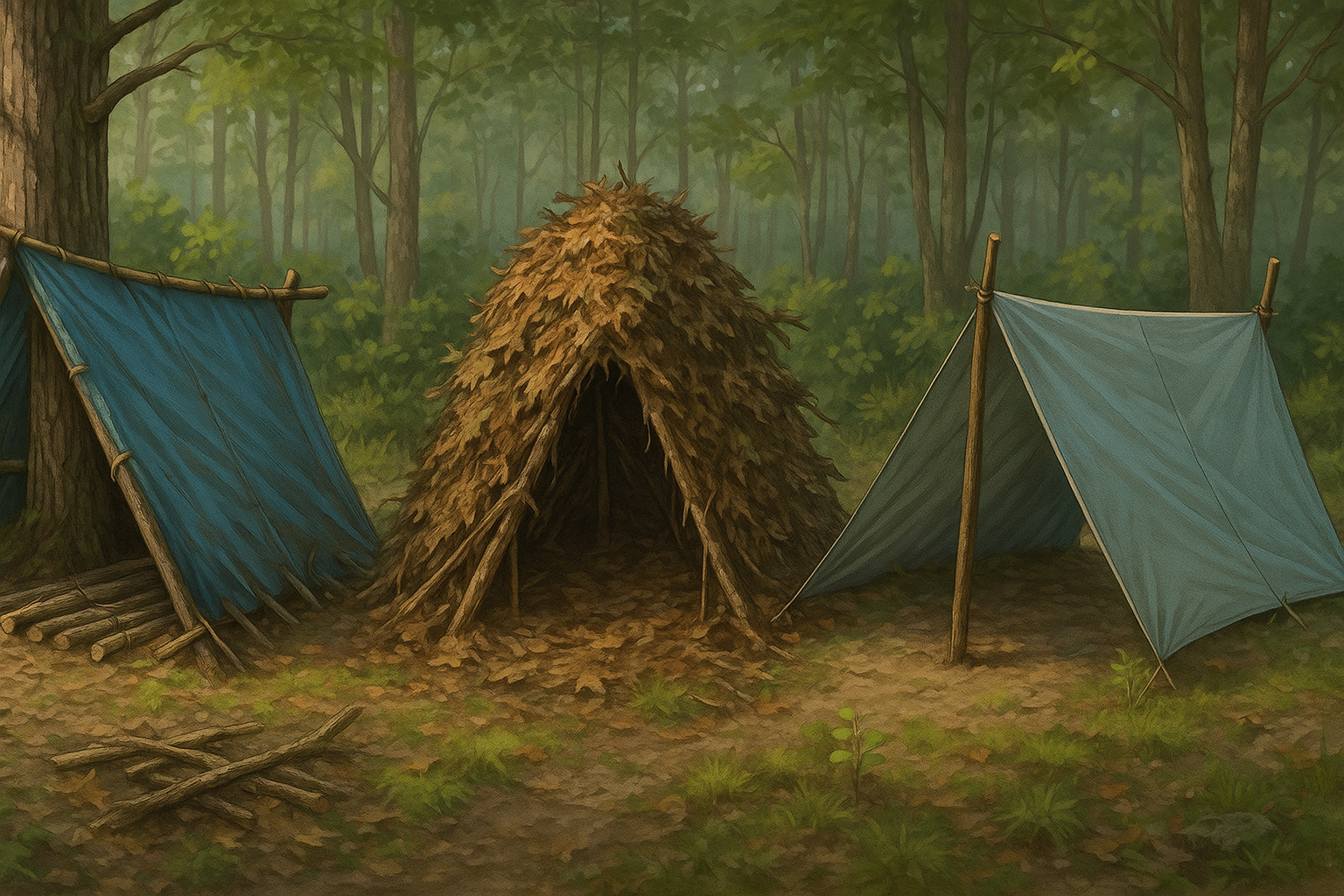Top 6 Essentials for DIY Emergency Shelters
When exposure can kill faster than hunger or thirst, shelter-building becomes a life-saving art. This guide draws from 100 Forgotten Survival Skills That Could Save Your Life — your blueprint for staying alive anywhere.
This post contains affiliate links. I may earn a small commission at no extra cost to you. Learn more.
Shelter Building Tools for Survival: Why They Matter
When you’re in the wild, your shelter isn’t just comfort — it’s survival. Shelter building tools for survival can mean the difference between staying safe and being exposed to the elements. Whether you’re setting up a lean-to, a debris hut, or an A-frame tarp shelter, the right gear makes the job faster, safer, and far more reliable.
Below are six essential tools that every survivalist, prepper, or backcountry camper should carry.
🪢 Paracord – The Survival Multi-Tool
Whether you’re crafting a lean-to, tarp tent, or full debris hut, paracord turns raw materials into a secure, weather-resistant shelter. This simple cordage is one of the most valuable multipurpose tools you can carry — and it weighs almost nothing.
✅ Tie ridgelines for tarps – String up a solid roofline between trees for quick weather protection.
✅ Lash poles together for frames – Build A-frames, ridge supports, or tripod structures that hold steady in wind and rain.
✅ Use inner strands for fishing line or snares – The seven inner strands can double as fine cordage for food gathering.
✅ Improvise field repairs – Replace broken boot laces, secure gear to your pack, or mend torn straps and zippers.
✅ Create emergency tools – Fashion a bow drill string, hanging hooks, or even a makeshift belt when needed.
💡 Why it matters: Paracord is light, compact, and incredibly strong. A single 50-foot length can replace multiple tools and save precious time during a shelter build or field repair. No serious survival kit is complete without it — keep a few coils ready in your pack, and you’ll always have options.
⛺ WiseOwl Tarp – Fast, Waterproof Shelter
A tarp is one of the most versatile shelter building tools for survival.
✅ Create lean-tos, A-frames, or ground covers
✅ Protect against rain, wind, and sun
✅ Packs small and sets up quickly
💡 Pro Tip: Pair with paracord and trekking poles for an instant weather-proof shelter.
🛌 Life Bivy Sack – Emergency Thermal Shelter
When the temperature drops and the wind starts cutting through your layers, this little orange bag can mean the difference between a miserable night and survival. The Life Bivy Emergency Sleeping Bag is designed to trap your body’s heat and shield you from the elements when you don’t have time — or energy — to build a full shelter.
✅ Reflects up to 90% of body heat – The heat-reflective mylar interior bounces warmth back to your body, reducing hypothermia risk in freezing conditions.
✅ Windproof and waterproof barrier – Seals out rain, snow, and biting wind so you can maintain core temperature even in brutal weather.
✅ Doubles as an emergency sleeping bag or bivvy – Large enough for full-body coverage and tough enough to use multiple times.
✅ Bright, high-visibility color – Makes it easier for rescuers to spot you in low light or forested environments.
✅ Ultra-light and packable – Fits easily in your bug-out bag, glove box, or even a jacket pocket.
💡 Why it matters: When the cold creeps in and you can’t build shelter fast, the Life Bivy buys you critical time. It traps heat, blocks moisture, and gives you a fighting chance to make it through the night — even when conditions turn deadly.
🌲 Silky Saw – Cut Materials Fast
When it comes to building serious shelter fast, a reliable folding saw is worth its weight in gold. It turns thick branches and stubborn saplings into workable support poles in seconds — no wasted energy, no dull knife abuse, and no broken limbs from overexertion.
✅ Quickly processes branches, poles, and saplings – Cut clean, even sections of wood for frames, ridgepoles, and crossbeams.
✅ Ergonomic, non-slip handle – Designed for long cutting sessions without blistering your hands or losing grip in wet conditions.
✅ Packs light but handles big jobs – Folds down small enough for a daypack yet strong enough to cut through wrist-thick branches.
✅ Efficient, pull-cut teeth design – Reduces binding and lets you saw smoothly even when wood is damp or fibrous.
✅ Durable, rust-resistant steel blade – Built to last through rain, snow, and long-term use.
💡 Survival Use: Without a saw, gathering poles for a debris hut or lean-to can take hours — with one, you’ll have sturdy supports ready in minutes. It’s one of the smartest energy-saving tools you can carry for any bushcraft or survival mission.
🚶 Trekking Poles – Dual-Purpose Shelter Support
Don’t underestimate trekking poles — they’re more than just walking aids. In survival or bushcraft settings, these lightweight tools become part of your shelter system, your balance support, and your energy management strategy all in one.
✅ Hold up tarp shelters as ridgelines or posts – Replace missing trees or sticks with sturdy adjustable poles to build fast, stable shelters anywhere.
✅ Provide stability over rough terrain – Conserve balance and prevent injuries while carrying heavy packs across rocks, mud, or steep slopes.
✅ Save energy on long hikes – Reduce strain on your knees and legs, especially when ascending or descending uneven ground.
✅ Double as defensive tools or probes – Test water depth, check snow pockets, or deter wildlife if necessary.
✅ Compact and adjustable – Collapses small for packing yet extends to fit multiple uses in camp and on the trail.
💡 Pro Tip: Adjustable poles let you fine-tune your tarp angles for wind and rain protection — creating better drainage and keeping your shelter steady in bad weather.
🛡️ Camping Tarp – Groundsheet & Weather Shield
A single tarp can save your life — but a second tarp can make your camp bulletproof. When conditions change, that extra sheet of waterproof fabric gives you the freedom to adapt your shelter setup, protect gear, or create a dry working area fast.
✅ Use as a groundsheet to stay dry – Keep moisture and cold from seeping into your sleeping area by layering a tarp beneath your shelter.
✅ Reinforce overhead tarps during storms – Double up for extra rain protection or to prevent sagging from heavy wind and water load.
✅ Act as a windbreak or sunshade – Set up secondary cover for cooking, gear storage, or shaded rest in hot weather.
✅ Create multiple shelters – One tarp for sleeping, another for gathering — perfect for group or extended survival setups.
✅ Emergency repair material – Cut or fold sections to patch holes, wrap wet gear, or even collect rainwater.
💡 Why it matters: Layering tarps keeps your shelter drier, more insulated, and far more versatile. Redundancy is survival — and a second tarp gives you backup protection when the weather or terrain turns against you.
📋 Quick Gear Checklist
Here’s your fast-glance survival shelter toolkit:
-
🪢 Paracord
-
⛺ Tarp
-
🛌 Life Bivy Sack
-
🌲 Folding Saw
-
🚶 Trekking Poles
-
🛡️ Extra Camping Tarp
Every twig shelter and lean-to teaches resourcefulness. See more classic fieldcraft methods inside 100 Forgotten Survival Skills That Could Save Your Life.
✅ Final Takeaway
Every survivalist knows: shelter is priority #1 in the outdoors. With these shelter building tools for survival, you’ll be equipped to create strong, reliable protection whether you’re in the forest, mountains, or facing an emergency close to home.
📚 Further Reading
👉 Don’t wait until it’s too late — pack these essentials now and you’ll be ready when nature tests you.













